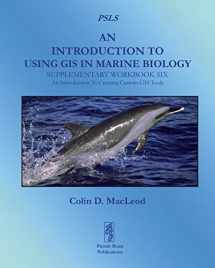
An Introduction To Using GIS In Marine Biology: Supplementary Workbook Six: An Introduction To Creating Custom GIS Tools
Book details
Summary
Description
This book is the sixth companion volume to ‘An Introduction To Using GIS In Marine Biology’. It is designed to augment the information on using GIS in marine biology provided in that book, and, indeed, to be used alongside it rather than to be used independently as a stand-alone volume. Therefore, this book will be of most interest to those who have already read ‘An Introduction To Using GIS In Marine Biology’.
This book consists of five exercises covering the practical use of GIS in marine biology using ESRI’s ArcGIS® 10.2 GIS software. These exercises are based around the creation of custom GIS tools to automate tasks which need to be done on a regular basis. These start with the creation of relatively simple tool to plot species locational data before progressing on to the creation of more complex custom tools and creating the appropriate metadata to accompany custom GIS tools. The exercises are designed to be followed in the order they are presented, and work with a specific data set which can be downloaded for free.
Working through these five exercises will help the novice GIS user obtain experience in creating custom GIS tools, and so develop their GIS skills. Unlike most other GIS tutorials, this information is specifically presented in a marine biological context and all the exercises use real data from a marine biological study. Therefore, these exercises are more likely to provide the kind of experience in using GIS that marine biologists will find useful and applicable to their own research.
These exercises are presented in the same easy-to-follow flow diagram-based format first introduced in the ‘How To...’ section of ‘An Introduction To Using GIS In Marine Biology’. They are accompanied by images which show the user how their GIS project should look as they progress through the exercises, allowing them to compare their own work to the expected results.
This is part of the PSLS series of books which use Task-Oriented Learning (TOL) to teach the practical application of research skills to the life sciences. This involves demonstrating how these skills can be used in the specific circumstances in which they are likely to be required rather than concentrating on teaching theoretical frameworks or on teaching skills in a generic or abstract manner. By seeing how the similar processes are used to achieve a variety of different goals within a specific field, it becomes easier for the reader to identify the general rules behind the practical application of these processes and, therefore, to transfer them to novel situations they may encounter in the future.
Table Of Contents:
Preface
1. Introduction
2. How To Use The ArcGIS 10.2 Software User Interface .
3. Exercise One: Creating A Custom Tool For Plotting Species Locational Data
4. Exercise Two: Creating A Custom Tool For Making Presence-Absence Data Layers Of Species Distribution.
5. Exercise Three: Creating A Custom Tool For Generating Polygon Grid Data Layers Which Have Been Clipped To Remove All Areas Of Land
6. Exercise Four: Creating A Custom Tool For Calculating Abundance Per Unit Survey Effort Using A Polygon Grid Data Layer.
7. Exercise Five: Creating Metadata For A Custom GIS Tool .


We would LOVE it if you could help us and other readers by reviewing the book
Book review



